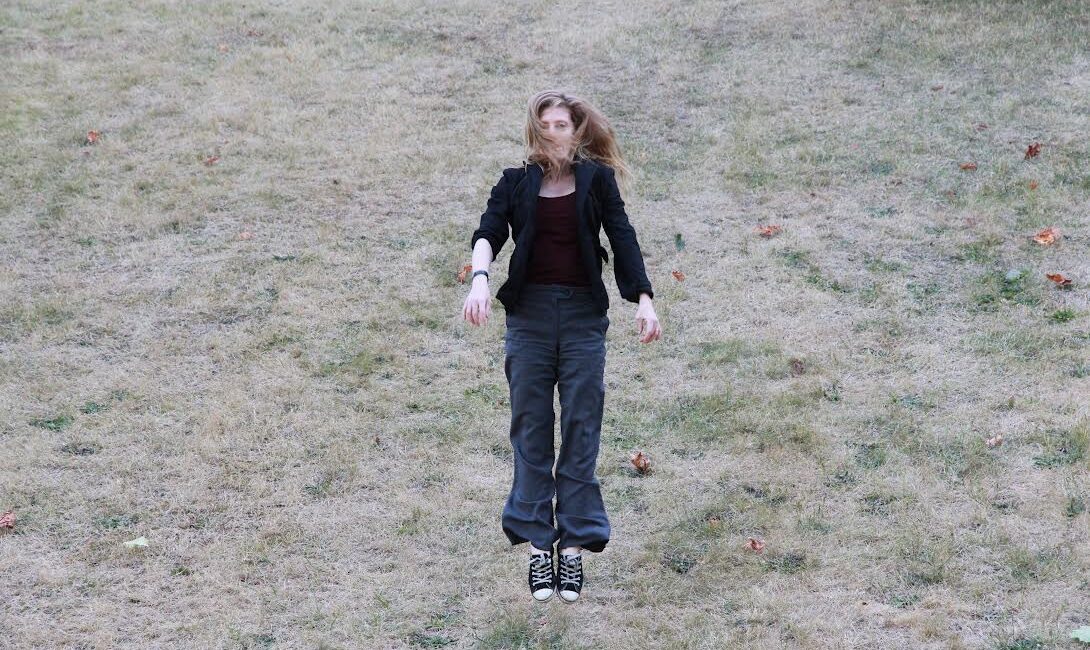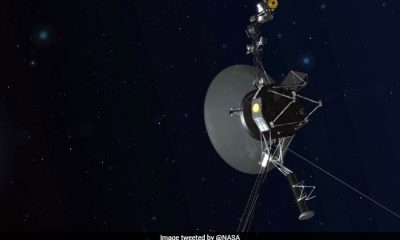Science
Japan's Upcoming Mission Will Use a Vacuum to Get its Sample From Phobos – Universe Today

JAXA, the Japanese Aerospace Exploration Agency, is carving out a niche for itself in sample-return missions. Their Hayabusa mission was the first mission to sample an asteroid when it brought dust from the asteroid Itokawa to Earth in 2010. Then its successor, Hayabusa 2, brought back a sample from asteroid Ryugu in 2020.
Now JAXA has the Martian moon Phobos in its sights and will send a spacecraft to sample it as soon as 2024. The mission is called Martian Moons eXploration (MMX), and it’ll use a pneumatic vacuum device to collect its samples.
Why go to Phobos and sample it? Because it’s an unusual moon and understanding it better could answer questions about it and our Solar System. And we always want more answers.
Phobos is the larger of Mars’ two moons, the other being Deimos. Both moons are irregularly shaped and look kind of like potatoes, especially Phobos. Phobos has a mean radius of only 11 km (7 mi). It’s closer to Mars than Deimos and orbits only 6,000 km (3,700 mi) from the planet’s surface. It moves rapidly, taking only 7 hours and 39 minutes to complete one orbit and completes three orbits each day.


Phobos is probably a captured rubble-pile asteroid, although astronomers still debate its nature. It has a lot in common with carbonaceous asteroids and is one of the least reflective objects in the Solar System.
The tiny moon is getting closer and closer to Mars. Every year it gets about 2 cm closer and will eventually be destroyed. In about 30 million to 50 million years, it will either smash into the surface of Mars and be utterly destroyed or be torn apart by tidal forces and form a debris ring around the planet. In fact, one hypothesis says that Mars’ moons were formed from dust created by a giant impact on Mars. Dust to dust, as they say.


Japan leads the MMX mission, but NASA, the CNES (France), and the DLR (Germany) are also contributing. It has two broad goals: (1) determining the origin of the Martian moons and (2) observing processes in the circumplanetary environment of Mars, based on remote sensing, in situ observations, and laboratory analyses of returned samples of Phobos regolith. Scientists think that a better understanding of the Mars-Phobos-Deimos system will shed light on the planetary formation process in the Solar System.
Getting a sample from Phobos faces several obstacles. The moon is not massive enough for a spacecraft to enter orbit around it in the usual way. Instead, MMX will enter orbit around Mars and then perform quasi-satellite orbits. Those orbits become unstable over time but should allow for several months of operation near Phobos. This maneuver also enables the MMX lander to reach Phobos’ surface.
JAXA designed the MMX mission with three components: a propulsion module, an exploration module, and the return module. The French CNES space agency suggested that the mission should also deploy a tiny rover about the size of a microwave to the surface, built by France and Germany.
But the highlight of the MMX mission will be the sample return. We’ve made enormous progress in sending instruments on spacecraft, landers, and rovers to examine Solar System bodies. When it comes to Mars, the in-situ study of the planet has unleashed a flood of new evidence and insights. But the holy grail in space missions is still sample return. No matter how advanced the instruments we send on missions are, lab analysis back on Earth will always outstrip them.
MMX will gather samples in two ways. One is the Coring Sampler (C-SMP) developed by JAXA. The other is the Pneumatic Sampler (P-SMP), contributed by NASA and developed by Honeybee Robotics.
The pair of samplers will complement each other and partially account for the fact that we don’t know what the surface is like. The Coring Sampler will be positioned on the lander’s robotic arm. It will use a special shape memory alloy to gather a 10-gram sample from deeper than 2 cm under the regolith.


The Pneumatic Sampler will be positioned near the footpad on one of the lander’s legs. It’ll use pressurized nitrogen gas to gather the samples, and mission operators can manipulate the gas flow depending on requirements. It can be either continuous or pulsed.


The P-SMP has three sets of nozzles to perform the procedure. Two excavation nozzles point downward, two retro thrust nozzles point upward, and two transport nozzles point toward the sampling tube. The three pairs of nozzles fire simultaneously.
The excavation nozzles fire at the surface of Phobos and stir up material from the regolith. The transport nozzles direct material into the sampling head. The retro thrust nozzles fire to counteract the thrust on the spacecraft, so its position is stable during sampling.
Honeybee Robotics has tested its P-SMP extensively and is confident that it can handle any surprises on Phobos’ surface. The company says its system can still gather a sample even if gravel covers the surface.
MMX won’t be the only mission to use Honeybee’s vacuum system. NASA plans to use it on the Moon to capture lunar regolith in Mare Crisium in 2023. The system is also being considered for a Europa Lander mission and several other missions still in the concept and design phase.
It’s easy to see why.
“The purpose of this technology is to allow simple and inexpensive capture of planetary materials from largely unknown surfaces,” said Honeybee project lead Kris Zacny. “Vacuum cleaners are designed to capture ‘dirt,’ hence a vacuum cleaner-like approach is ideal for working with planetary ‘dirt.’”
More:
Science
NASA hears from Voyager 1, the most distant spacecraft from Earth, after months of quiet
|
|
CAPE CANAVERAL, Fla. (AP) – NASA has finally heard back from Voyager 1 again in a way that makes sense.
The most distant spacecraft from Earth stopped sending back understandable data last November. Flight controllers traced the blank communication to a bad computer chip and rearranged the spacecraft’s coding to work around the trouble.
NASA’s Jet Propulsion Laboratory in Southern California declared success after receiving good engineering updates late last week. The team is still working to restore transmission of the science data.
It takes 22 1/2 hours to send a signal to Voyager 1, more than 15 billion miles (24 billion kilometers) away in interstellar space. The signal travel time is double that for a round trip.
Contact was never lost, rather it was like making a phone call where you can’t hear the person on the other end, a JPL spokeswoman said Tuesday.
Launched in 1977 to study Jupiter and Saturn, Voyager 1 has been exploring interstellar space – the space between star systems – since 2012. Its twin, Voyager 2, is 12.6 billion miles (20 billion kilometers) away and still working fine.





Science
SpaceX launches 23 Starlink satellites from Florida (photos)


|
|
SpaceX sent yet another batch of its Starlink internet satellites skyward today (April 23).
A Falcon 9 rocket topped with 23 Starlink spacecraft lifted off from Florida’s Cape Canaveral Space Force Station today at 6:17 p.m. EDT (2217 GMT).
The Falcon 9’s first stage came back to Earth for a vertical landing about 8.5 minutes after launch as planned. It touched down on the SpaceX droneship Just Read the Instructions, which was stationed in the Atlantic Ocean.
It was the ninth launch and landing for this particular booster, according to a SpaceX mission description. Five of its previous eight liftoffs were Starlink missions.
The Falcon 9’s upper stage will continue carrying the 23 Starlink satellites toward low Earth orbit (LEO) today, deploying them about 65 minutes after liftoff.
This evening’s launch was the 41st of the year for SpaceX, and the 28th of 2024 dedicated to building out the huge and ever-growing Starlink megaconstellation. There are nearly 5,800 operational Starlink satellites in LEO at the moment, according to astrophysicist and satellite tracker Jonathan McDowell.
The Starlink launch ended up being the first half of a spaceflight doubleheader: A Rocket Lab Electron vehicle launched two satellites, including a NASA solar-sailing technology demonstrator, from New Zealand today at 6:33 p.m. EDT (2233 GMT).
Editor’s note: This story was updated at 6:30 p.m. ET on April 23 with news of successful launch and first-stage landing.





Science
Exploring ecological networks in a digital world | News | Vancouver Island University | Canada – Vancouver Island University News


Getting to know Samantha Letourneau
By day, Samantha Letourneau is Vancouver Island University’s Canada Learning Bond project lead and Volunteer Tutor Coordinator. She’s also a musician and dancer and for the past two years, she’s been collaborating with Swedish artist Mårten Spångberg, thanks to funding obtained through Crimson Coast Dance, to create a digital art installation that goes live on Friday, April 26. A launch event takes place at Black Rabbit restaurant in the Old City Quarter that night. Samantha is also hosting a creative process workshop on April 27 and 28.
Can you share a bit about your background as an artist and how you got into it?
I have been working in art for a very long time, as a musician and dancer as well as an art administrator and program coordinator. I started music at the age of 11 and dance came later in my life in my early 20s. I always wanted to do dance, but I grew up in a small community in Yellowknife and at that time the only dance classes available were highland dancing, which I was not very interested in.
In my early 20s while living in Vancouver, I took classes in contemporary dance and was fortunate to land a small part in the Karen Jameison Dance company for a piece called The River. The River was about rivers and connection between the reality of a real and physical outdoor river and the different reality of “the river within.” It was both a piece of art and outreach for the community. It included working with the S’pak’wus Slu’lum Dancers of the Squamish Nation. Somewhat ground-breaking for 1998.
From there I was hooked and wanted to do more in dance. I studied a lot and took many classes. Fast forward to now, I have been involved with productions and performances with Crimson Coast Dance for more than 15 years and greatly appreciate the talent and innovation that Artistic Director Holly Bright has brought to this community. She is amazing and very supportive of artists in Nanaimo.
How did this international exchange come about?
The Nordic/Nanaimo exchange is one of the innovative projects Holly created. At the height of the pandemic, funded by BC Arts Council and Made In BC, Crimson Coast Dance embarked on a project that explored the ways in which Nanaimo artists could participate in online exchanges.
Two artists in Nanaimo – myself and Genevieve Johnson – were introduced to artists from Europe and supported through this international exchange. My collaborator, Mårten Spångberg, is a Swedish artist living and working in Berlin. An extension of that exchange is funded by Canada Council for the Arts – Digital Now.
What brought Mårten and myself together – and I quote Mårten here – is “questions around climate change, ecology and the influence contemporary society has on its environments. We are not interested in making art about the ecological crises or informing our audience about the urgency that climate change implies, but instead through our research develop work that in itself proposes, practices and engages in alternative ecologies.”
We share an understanding that art is a unique place, in the sense of practice, activation, performance and event, through which alternative ecologies can emerge and be probed and analyzed.
Tell us about the launch event.
We are launching the digital art installation that Mårten and I created on April 26 at The Attic at Black Rabbit Restaurant. The event is free to attend but people must sign up as seating is limited. I produced video art with soundscapes that I recorded mixing field recordings with voice and instrumentation. Marten explores text, imagery and AI.
My focus is on the evolving and ongoing process of how we communicate with each other and to nature within a digital context.
During our collaboration, Mårten and I talked about networks, though not just the expansive digital network of the internet but of nature. We shared thoughts on mycelium, a network of fungal threads or hyphae, that lately has received much attention on the importance of its function for the environment, including human beings.
Building off this concept, ideas of digital and ecological landscapes being connected emerged. From this we worked both collaboratively and individually to produce material for this digital project. Mårten will be there via Zoom as well and we will talk about this two-year process and the work we created together.
-



 Health6 hours ago
Health6 hours agoRemnants of bird flu virus found in pasteurized milk, FDA says
-
Art12 hours ago
Mayor's youth advisory council seeks submissions for art gala – SooToday
-
News18 hours ago
Some Canadians will be digging out of 25+ cm of snow by Friday – The Weather Network
-



 Health10 hours ago
Health10 hours agoBird flu virus found in grocery milk as officials say supply still safe
-



 Science19 hours ago
Science19 hours ago"Hi, It's Me": NASA's Voyager 1 Phones Home From 15 Billion Miles Away – NDTV
-
Media17 hours ago
Jon Stewart Slams the Media for Coverage of Trump Trial – The New York Times
-
Art24 hours ago
Made Right Here: Woodworking art – CTV News Kitchener
-



 Investment10 hours ago
Investment10 hours agoTaxes should not wag the tail of the investment dog, but that’s what Trudeau wants




